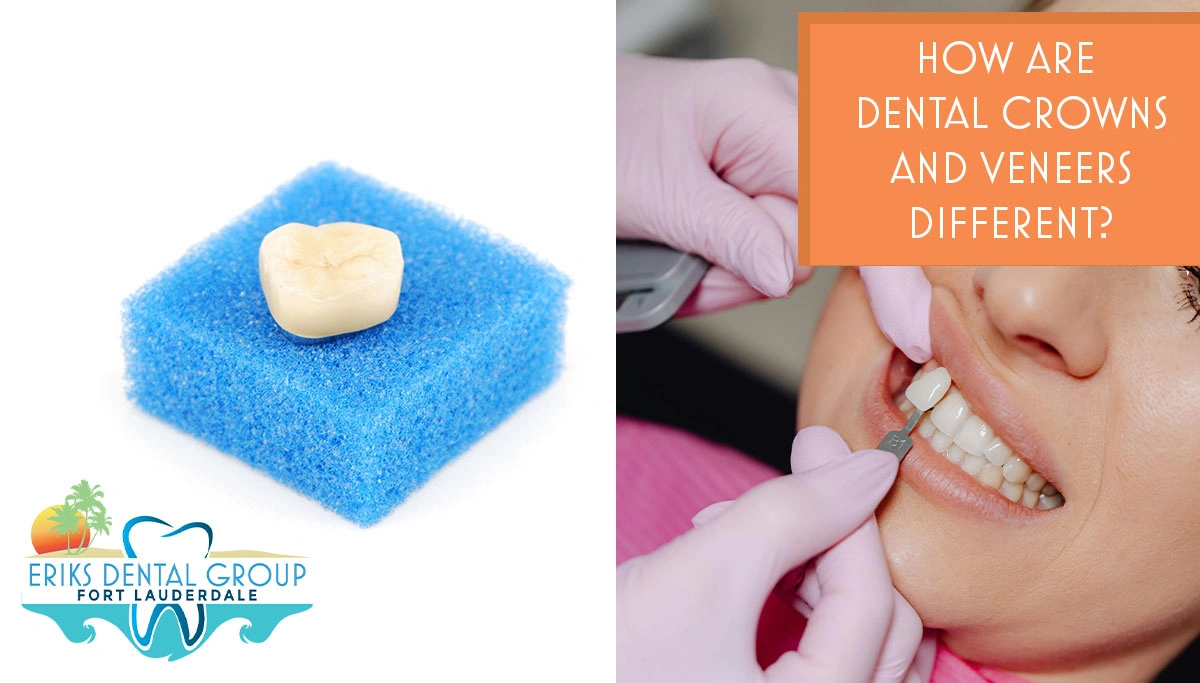
Crowns and veneers are dental restorations that improve how your teeth look, but they are entirely different procedures. While dental crowns cover the entire tooth, veneers are only used on the front surface for cosmetic reasons. Additionally, crowns are primarily used for restoring damaged teeth from injury or tooth decay.
On the other hand, veneers usually correct cosmetic imperfections like chipped teeth, misalignment, or discoloration. Both options can be made from different materials. Dental crowns are more long-lasting, unlike veneers, which need to be replaced every few years.
If you’ve been thinking about dental crowns versus veneers, we’re here to provide some clarity! Keep reading as Dr. Ty Eriks breaks down each dental procedure and answers any questions you might have.

Dental crowns are tooth-shaped coverings that restore weak, worn-down, broken, cracked, or otherwise damaged teeth. They are also used to cover root canal-treated teeth or dental implants. A crown fits over your entire tooth and can be made of ceramic, porcelain fused to metal, metal, or pressed ceramic. To ensure it fits properly, a dentist removes a small amount of your enamel before bonding the crown into place.
Getting a dental crown usually requires two visits unless you choose the same-day dental crowns. During the first visit, we will take X-rays and examine the tooth and the surrounding ones to ensure there is enough bone to hold the crown in place. If there is a lot of tooth decay, we may also suggest a root canal before proceeding. After this exam, we will take teeth impressions to create a custom dental crown. A temporary is placed until your final restoration is ready.
During the second visit, we remove the temporary. Next, we clean the tooth and fit your new crown in place. We will have you test the bite and finish off by taking an X-ray to verify that the crown fits well. With proper oral hygiene and regular dental exams and teeth cleanings, a crown can last as long as 10-15 years.
Dr. Eriks helps his patients understand when getting dental crowns is beneficial. However, there will be some signs that you may need a crown too, including:

Veneers are thin porcelain shells that are bonded directly to the front of your teeth. They not only repair and restore a smile but also conceal gapped or crooked teeth with them. Veneers can change the shape, length, color, and size of your teeth instantly.
When you want to change how your smile looks, veneers are a cosmetic dentistry treatment that can help. During a smile makeover, Dr. Eriks and his team will discuss your teeth goals to help you achieve your dream smile.
The ideal candidate for veneers is someone who wants to repair tooth discoloration, chips, cracks, or gaps in their teeth. They are recommended only to patients with healthy teeth and gums who don’t grind their teeth or have gum disease. Any existing dental issues must be resolved before getting veneers.
When you arrive at Eriks Dental, Dr. Eriks will examine your teeth to determine if you’re a qualified candidate. After this is determined, they will begin the veneers process by taking off some of the natural enamel. This allows room for your porcelain veneers. Next, impressions of your teeth are taken and sent to a lab. A set of temporaries is placed until your permanent set is ready.
When they’re ready, you’ll return to our office, and we will remove the temporaries and bond the permanent ones. We will adjust as needed to ensure that they fit comfortably for you.
When it comes to veneers, there are many benefits for a patient to get them, including:
While they last less time than dental crowns, they do provide an instantly changed smile. They can also make your teeth more sensitive, as some of your tooth enamel is removed during the prep. Because of this, this makes them irreversible as your natural teeth are weakened.
At Eriks Dental, we treat our patients like we would our own family, and we pride ourselves on making you feel comfortable while you’re here, and when you go home. To learn more about our range of dental services, call our office at 954-463-5051 or schedule a dentist appointment online.
© 2025 Eriks Dental Group - Fort Lauderdale - All Rights Reserved. Dental Website Design by Connectica